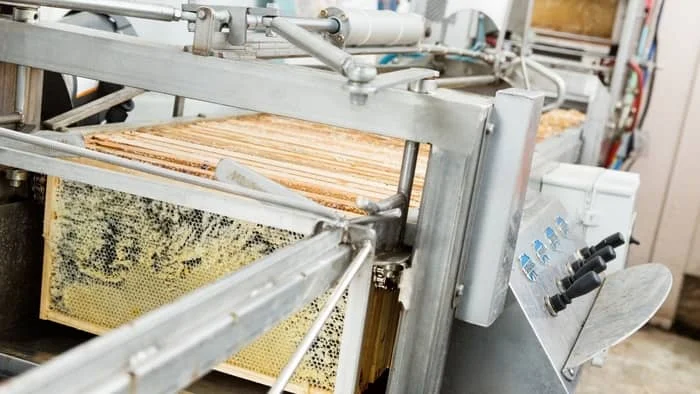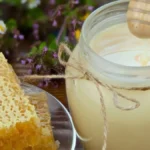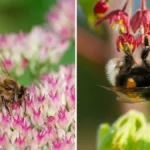When we ask what is the difference between raw honey and pure honey we open a can of worms. There is so much confusion around honey labeling, and a lot of people get confused. In this article, we take a look at the difference between raw honey and pure honey. This necessitates a wander through the minefield of terms around this – unfiltered, natural honey and some clarification on the difference between raw honey and regular honey.
What Is Honey
Honey is a concentrated sugar solution made by bees. Bees collect nectar from flowers and use enzymes to convert the complex sugars in this nectar into simple sugars – mainly glucose and fructose with a residue of sucrose. Depending on what flowers the bees were working on there can be lots of other traces of minor sugars. But for 99% of honey, Glucose, Fructose, Sucrose, Water, a few enzymes, salts, proteins, pollen, and color and flavor compounds are what we call honey.
Bees store honey in a honeycomb.
Honeydew
If bees collect a sugar solution that is not from a flower and process this it is called honeydew. As an example, bees will sometimes bite grapes and collect grape juice. In other places, such as the Black Forest in Germany, aphids infest trees in late summer and the bees will squeeze the aphids making them emit a drop of “nectar” which they collect.
In other parts of the world, when sugar cane is cut, the stems seep and bees collect this sugar solution.
If bees process this, the product is not directly derived from flowers, hence it cannot be called honey – it is instead called “honeydew”.
Occasionally, unscrupulous beekeepers feed sugar to bees, and then the bees store this sugar. This is also not honey. It is just a crime.
Honeycomb
This is the simplest form of honey. It consists of honey in beeswax cut from the combs in the hive. If the bees were working on flowers, then this is a pure honeycomb. There are parts of the world where you have to be careful that certain chemicals used to control Varroa mites have not accumulated in the wax. If the beekeeper followed best practices for chunk comb production this risk is minimized.
I have worked in various beekeeping operations in Africa where all the honey produced is actually from the cut comb. An advantage of this method is that it is easier to prove your honey is organic. Zambezi Gold honey is widely available in the US and is genuine organic honey. It is only really possible to produce real organic honey in the wilds of Africa, as few other places have healthy bees that do not need medicine or healthy ecosystems that have not been drenched in pesticides.
_JPG.webp)
Extracted Honey
The majority of honey in the world is produced by extracting honey from honeycombs built into frames. This honey is spun out with a honey extractor. Once the honey has been extracted there are a number of things that can be done to it, depending on the quality of the extracted honey. This will determine what we can call the honey on the label.

Unfiltered Honey
This is a grey area. Technically a strain is a filter. Anyhow, normally this honey will be run through a course strainer – typically hole sizes in the 1/5 to 1/8 inch range to remove big chunks of wax, pieces of wood, bees, and other gunk that got into the extractor. I once found a bolt from my extractor in the strainer. This was after the extractor broke.
If a beekeeper settles this honey in a tank, the wax particles that made it through the strain will float to the top, and the heavy particles of sand and such that find their way into honey somehow, settle to the bottom. The middle bit can then be bottled and is unfiltered, unheated, natural honey. It will probably have a few bee legs, wings, and particles in it.
Filtered Honey
To filter honey through a finer filter – typically 100 microns or so, it is strained, then heated quickly in a flash heater and pushed through a filter bag, or some other filter. This will remove bee legs, pollen, small crystals, and sand from the honey.
It is therefore a case that filtered honey is normally also pasteurized honey – it has been flash heated.
Filtered honey tends to be clearer looking and is more attractive to the uneducated honey consumer. The heating process reduces the risk of crystallization. For some reason, consumers hate crystalized honey. This is just a pity. Some honey crystallized fast, some slowly. If we have to heat and filter honey, to make people buy it, my feeling is they should rather eat syrup.
Unnatural Honey
There are many cases where we can solve problems with technology. Sometimes we solve problems before asking “should we solve the problem”. In parts of the world where humidity is high, bees struggle to ripen the honey. This honey can be harvested as “unripe” honey.
Unripe honey has a higher moisture content and will consequently ferment. If beehives cannot be properly ventilated due to high humidity, beekeepers can use other systems to ripen honey. Technologies exist which allow you to dilute unripe honey further with water, then ultra filter it, pass it through reverse osmosis membranes to remove water, and then produce what is technical specification “honey”.
I see no logical reason why one would do this, and the filtration process removes any natural elements from the honey. This is one of those cases where energy is spent doing something that should just not be done.
Raw Honey Vs Regular Honey
If we assume raw honey to be the honey straight from the hive, either in the comb, or strained, but not filtered, and regular honey to any of the other honey-like products on the shelf, the choice is easy. When you want a product that has the benefits of honey, then raw honey is worth it. If you want a sugary thing that tastes like honey, then the other options will work.
For me, I like to eat my own honey, or honey I buy from beekeepers I know. I swop honey with beekeepers as well. This is much like how wine and mead makers swop their beverages with other producers. It is boring eating too much of your own honey, and, as a connoisseur, it is nice to get in other honey that you can trust.
Read more about: At What Temperature Does Raw Honey Lose Its Benefits?
How To Make Sure Your Honey Is Real
The best way is to produce your own – once you taste this you will know what the difference between raw honey and pure honey is. Your honey is the best! Always.
If that fails, then buy from a certified organic operation if you buy it at a shop. The organic certification process is very rigorous and they check and maintain audit trails.
When you know other beekeepers buy from them. Buying at farmers’ markets where you can meet the beekeeper is another option. Supporting local beekeepers supports you! Their bees pollinate the food that is produced closest to you, so supporting your local beekeeper supports your local economy. We should all try to source as much as we can from withing about 60 miles of where we live.
Honey, milk, fruit, vegetables, cannabis (if legal in your area) and other medicinal plants are increasingly locally available. Buying local supports your local economy and reduces your carbon footprint. Buy local Bee local.
What is the difference between raw honey and pure honey? We hope this helped you understand how weird the honey world is and how difficult this question is to answer. I hope this helps you make informed decisions on what you buy, and what you expect from the different honey options out there. If you enjoyed this, please share – and buy local, Bee local.
Learn more about: How Much Honey Can You Get From One Hive?

Dr. Garth A. Cambray is a Canadian/South African entrepreneur and beekeeper with 28 years of experience in apiculture and specializes in adding value to honey. His Ph.D. research developed a new advanced continuous fermentation method for making mead that has resulted in a number of companies globally being able to access markets for mead. His company, Makana Meadery, exports honey mead to the USA where it is available to discerning connoisseurs. He has also developed technologies to commercially manufacture organic honey vinegar in Zambia for export globally. He holds a few patents globally in the ethanol industry and believes in technology and knowledge transfer for human development and environmental sustainability. One of his proudest achievements is the fact that the wind farm he started at one of his old apiary sites has essentially made his hometown carbon neutral.






